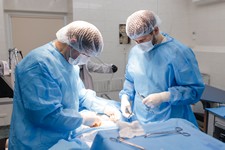

















Laparoscopic Cystectomy
Ovarian cysts are formations that develop on or inside the ovaries. There are several types of cysts. The most common are benign, do not cause symptoms, and disappear over time without treatment. However, there are certain types of ovarian cysts that require surgical treatment, such as dermoid cysts, endometriotic cysts with papillomatous inclusions, and others.
What are the main causes of ovarian cysts? The most common causes of ovarian cysts are:
- Hormonal disorders, such as polycystic ovary syndrome (PCOS)
- Ovulation or the use of medications to induce ovulation
- Endometriosis
- Pelvic inflammatory disease
- Cancer
What is laparoscopic cystectomy?
Ovarian cystectomy is surgery to remove a cyst from the ovary. Laparoscopic surgery is a minimally invasive surgical technique that involves only a few small incisions in the lower abdomen. Typically, two 5 mm incisions and one 10 mm incision are made.
When is laparoscopic cystectomy performed?
Many women develop an ovarian cyst at some point in their menstrual cycle. Usually, cysts cause almost no symptoms and often disappear on their own without treatment. These are called functional cysts. However, if the cyst causes pain or discomfort, surgical removal of the cyst may be the best treatment option.
Details of the procedure
How to prepare for ovarian cyst removal?
During our meeting, I will tell you how to best prepare for the surgery. The preparation instructions will include things like when to stop eating and drinking, when to stop taking medications, and when to arrive at the hospital. Be sure to ask any questions before the day of the surgery.
What happens during the surgery?
The surgery is performed under general anesthesia. A laparoscope—a thin tube with a camera at the end—is inserted into the abdominal cavity, usually at the navel through a small incision. Additional two incisions (5 mm) will be made on the abdomen. To create more space between the abdominal wall and the internal organs, air will be used. The cyst is removed with the help of special thin laparoscopic instruments. During the surgery in our facility, we have the possibility to send the ovarian cyst for histological examination and get the results within 15-20 minutes, which is extremely important for the patient as we immediately know whether it is a benign or malignant cyst.
Why do I prefer laparoscopic cyst removal over a conventional abdominal incision?
Since the surgery is minimally invasive, it allows for easier and faster recovery compared to open surgery. The hospital stay duration after laparoscopic cystectomy is usually between 24 to 48 hours. However, if there is suspicion of ovarian cancer or if the cyst is too large for laparoscopic removal, open surgery may be the only option.
What to expect after the surgery?
After the procedure, it is normal to have pain and possibly bruising around the navel and abdomen. Your shoulders and back may hurt due to the gas used in the abdomen during surgery. These pains usually subside within three days. You may have spotting from the vagina after surgery.
The abdominal incisions will be closed with special dissolvable sutures. Dressings are applied throughout the hospital stay, and after discharge, no further dressings are needed. The sutures on the abdomen need to be removed 12-14 days after the procedure. You can take a shower the day after the surgery, but do not rub the incisions.
In the first week after surgery, you may feel more tired than usual. Gradually increase your activity with short walks. Sexual activity can be resumed when you feel comfortable.
We will discuss all questions regarding the surgery and the postoperative period during our meeting at the clinic.
You can view these and other surgeries on my YouTube channel.





